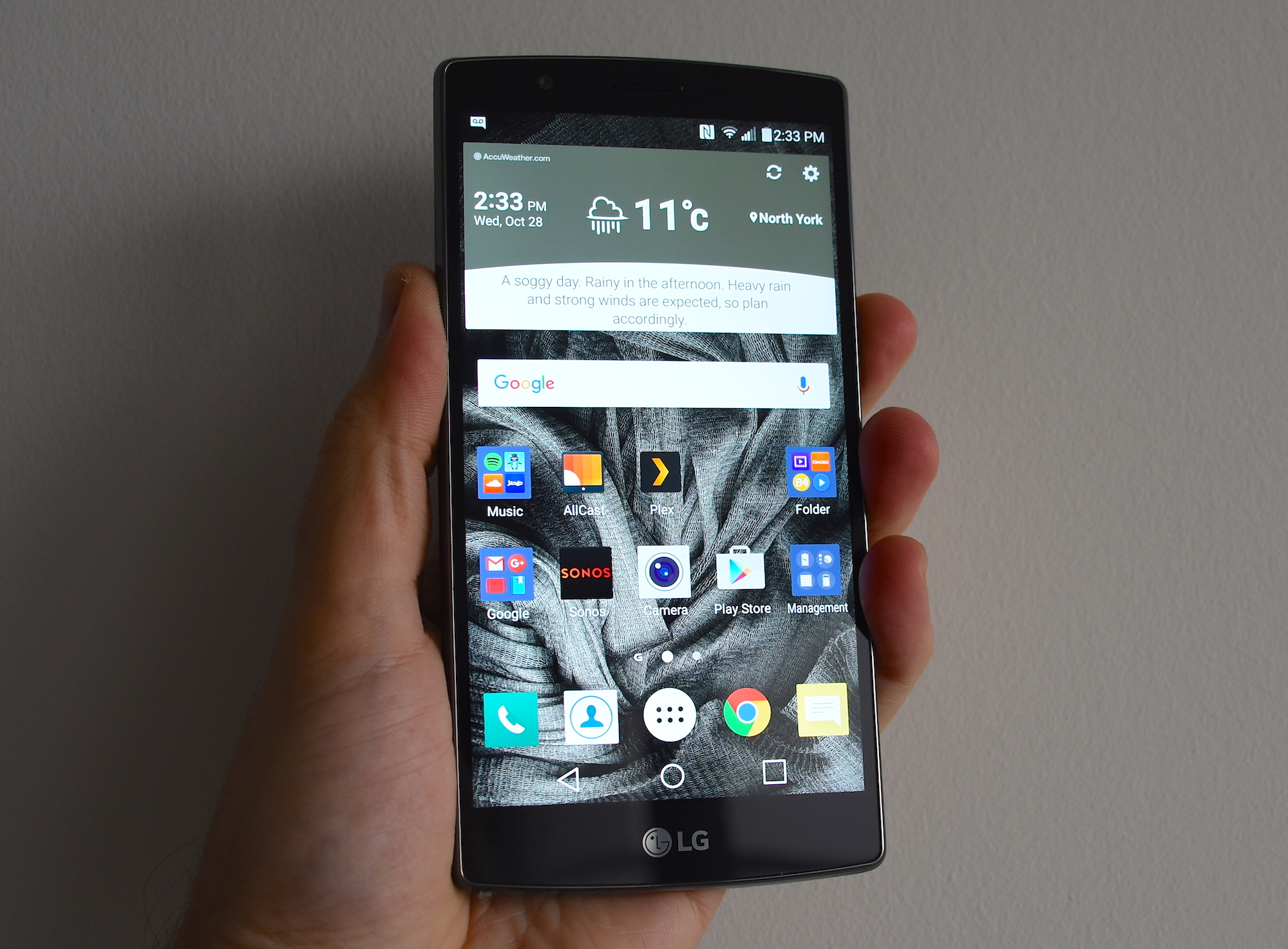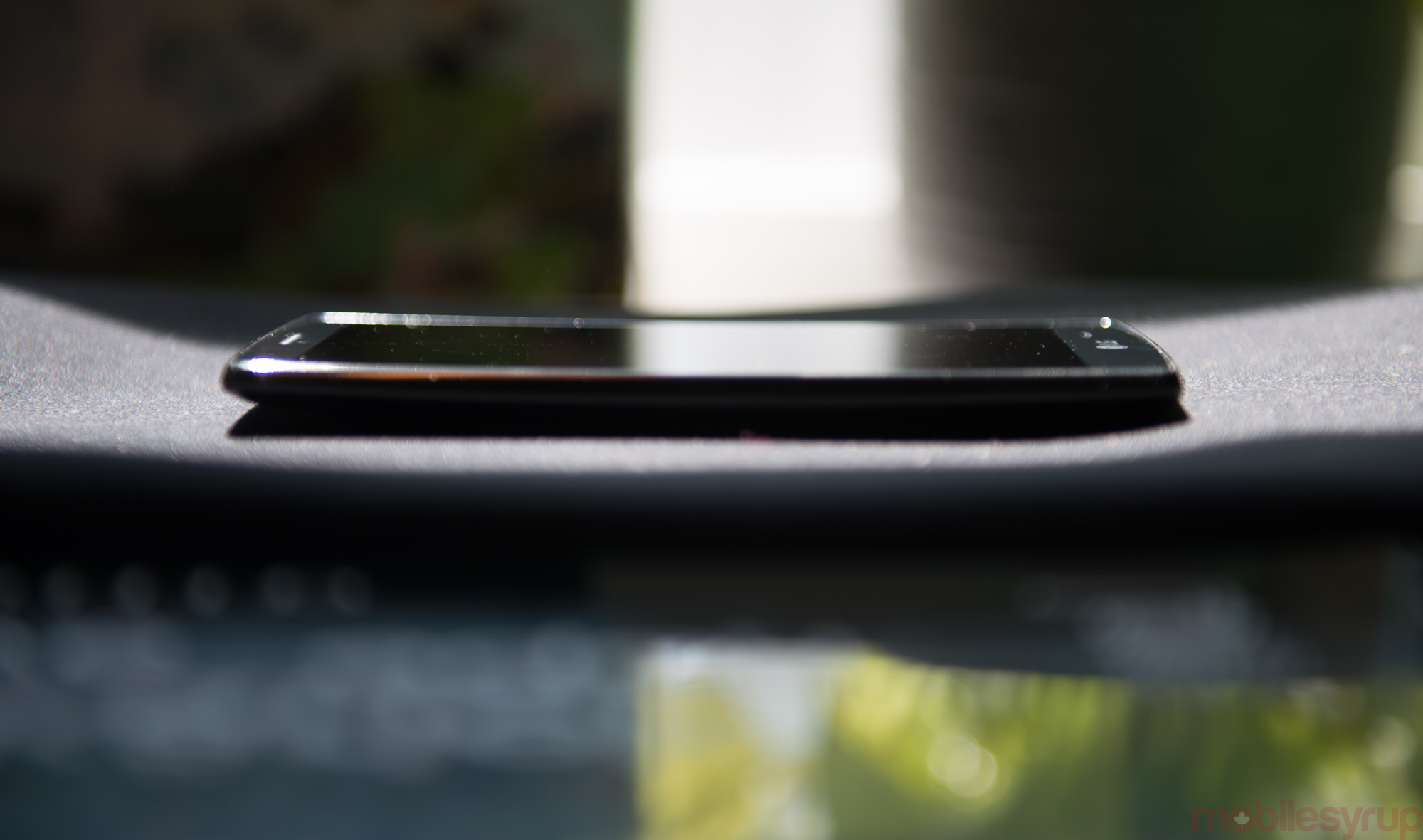
For LG executives, it must be hard to look at Samsung’s mobile success and not feel a sour taste, given how hyper-competitive the Korean electronics industry is.
In trying to stand out in the crowd, LG has chosen to highlight features it believes users care about. The camera is chief among these, followed by a design philosophy that finally shows some consistency from a brand that lacked it for too long.
That being said, the G4 is easily the best smartphone LG has produced, from the inside out. Tasteful, without being gaudy or overly gimmicky, this was a phone that launched in the middle of everyone else’s dip into the 2015 smartphone pool.
Too little, too late, or does this underdog have more bite than bark, now that the field has filled up with all the players?
The device
I’ve had the luxury of using this for close to six months, even though it’s only been available for four. It was immediately apparent that the G4 followed the same design philosophy of the recent past for LG, and in doing so, pivoted to a material no one else uses.
In a world where glass, metal and plastic rule the roost, LG figured it would give leather a shot. Not garden-variety “genuine” leather, but the luxurious full-grain. For something that reportedly goes through the same treatment process as luxury brands like Coach and Louis Vuitton, the value of such a decision becomes more obvious with time.
The leather back has held up very well for me, and it’s one of the few devices that I wouldn’t want to put a case on. My opinion differed completely with the ceramic model, which was nice on its own, but never gave me the same feeling.
The feeling of real leather compared to the faux pleather of the Galaxy Note 4, for example, is something that shouldn’t be understated. And considering how much LG loves curves, the contours of the G4 aren’t difficult to get used to, following the lineage of the G3 and, to some degree, the G Flex.
A removable back is becoming less common in premium Android circles, but LG has stuck to it. A micro SIM is also a little unusual by now, and microSD expansion isn’t always a surety anymore, either. The tinny speaker is among the poorest in its class, so there is always a trade-off when choosing to squeeze in one or two other features. Not to mention that having physical buttons on the back has caught on a bit with other manufacturers.
The G3’s screen packed in a lot of pixels while suffering from poor backlighting and a little too much sharpness. The G4’s, on the other hand, maintained the same 5.5-inch QHD resolution as its predecessor, but made it brighter, more colour accurate, and considerably less fuzzy.
The software
If there was a ranking for this category over the last few years, even limited to Android handsets, LG’s version would likely rank as a bottom-feeder. The G2 was excessive, to say the least. The G3, less so, while still lacking aesthetics and intuitiveness. KnockOn is still great, standing idly in retaining its legacy throughout, which is more than what can be said of LG’s other software experiments.
The company restrained itself further with the G4, yet seems to lack a coherent vision on how it wants its infusion to Android to appear. Maybe it’s just me, but the more I used the device, the more I realized why there is a bubbling backlash against third-party overlays.
The G4, on Android 5.1, has let in a little more Lollipop through the cracks. Swiping left from the home screen still shows LG’s Smart Bulletin instead of Google Now, but after setting it up, saying “OK Google” from any screen on the device lights up the helpful tool. The multitasking screen is also very Lollipop, looking no different than any other Android phone running the same version.
Unfortunately, the notification pane lacks the simple effectiveness of the stock one. There is no double-down swipe, and basic functions, like Cast Screen, are nowhere to be found. I used the Chromecast app (and AllCast) as a workaround, yet felt like I was going through a step I shouldn’t need to. I’ve become accustomed to seeing it on the quick settings pane in other Android devices.
As for LG’s contributions, I grew to like the context Smart Notice provided on the home screen for things like the weather or battery drain from a specific app. LG claimed this was a learning platform, and yet, it didn’t learn enough about me to provide more personal context. Weather updates are great, except not telling me much about traffic when there’s a meeting already listed in my calendar is an omission that irks.
Event Pocket promised a lot, too. The idea was to unify information from various apps, including Facebook, into one user-friendly calendar. Great in theory, save for the fact it wasn’t all academic. I had to remember to drag-and-drop invites and other details into the calendar. I fully admit I’m not the most ardent calendar user, but a little more automation in this respect would’ve been appreciated. If I say yes to an event invite on Facebook, why do I have to drag the event into my calendar? It should do it on its own.
I came away with mixed feelings about Smart Settings as well. I found it a great landing zone for automating some of the mundane fixtures in using the G4, and I figure less tech-savvy users will agree, whereas seasoned smartphone users will look to something more robust on Google Play to do the job.
With subsequent core updates along the way, LG has stripped away some of its own pieces. While I highlighted the shortcomings above everything else, the G4 is heading in the right direction on the software front, and with an impending update to 6.0 Marshmallow coming up, there is reason for optimism that it will only get better.
As it stands…
Much of this section focuses on the camera, and with good reason. I continue to be impressed at how sublime the G4’s is. Mind you, I shoot 90% of the time on it using the Manual mode, and that’s partly because the interface is the best I’ve seen for adjusting settings. It’s not easy to take a quick snap when trying to adjust the shutter or exposure on the fly, but for any shot where I have a little time to prepare, I don’t even bother with going Auto.
The wide f/1.8 aperture is surely helpful, especially in low-light and night shots, and it seems the company may have been on to something with its Colour Spectrum Sensor. Composition and colour balance never seemed to be distorted, skewed or oversaturated. White balancing may have leaned too far, in some cases, but the camera’s overall consistency was always welcome. Having good optical image stabilization (OIS) also helps a great deal when shooting at night or trying to freeze a moving a object with a higher shutter.
On a summer trip to Cuba, the G4 was my point-and-shoot camera. I didn’t capture enough while I was there because I was too busy lounging, but some of the shots I did get turned out far better than what others were able to get on their respective phones. Again, I usually shot in manual, though managed excellent results in auto as well.
The problem is that LG’s success is also its curse. Most smartphone users are either unaware or intimidated by manual controls, and so, the full breadth of the G4’s camera isn’t widely understood until it’s shown to people. I noted this dichotomy on a few too many occasions, both in Cuba and back home in Toronto, where people I encountered were shocked the G4 was capable of taking photos on par, if not better, than the iPhones and Galaxys they were wielding.
This is a marketing opportunity LG has seemingly stumbled to reap. In a year where camera performance surfaced as a differentiator, it’s not clear that the G4 has entered consumer consciousness as a device to be reckoned with.
Perhaps part of the reason for that is due to Samsung also upping its camera game. This year’s crop of Galaxy flagships were the best LG’s Korean rival mustered for photos. Sony has long been adept at offering solid camera performance, and that hasn’t helped woo enough users over. HTC was good, yet faltered with the One M9. Nexus devices were never valued highly for their imaging prowess. Motorola also struggled to get it right.
In other words, it’s a mixed bag, and the G4 shines in spite of it. So then, how does a phone like this stand out when the market is dominated by two front-runners, with a pack fighting for what’s left behind? LG finds itself in the middle of it all — an underdog that is quietly getting better and more sensible about what a smartphone should be, and in need of a way to claw it’s way up the charts to be heard.
It’s almost a wonder if an ‘anti-hero’ type of device will emerge. The sort of handset that flips a middle finger at the established winners at the top, offering the chance to woo consumers who like that message. LG will have to take a number to be in that role. Where OnePlus, Motorola and the rising Chinese brands like Huawei and ZTE, are all trying to sway consumers further down the price point, LG will likely need to build off of the G4 to cultivate a more enduring image.
Like the G3 is today, the G4 will be a sub-$500 budget phone by this time next year. That will give it a longer life, and it will be interesting to see if its second lease on life comes on the heels of a banner year for the company.
MobileSyrup may earn a commission from purchases made via our links, which helps fund the journalism we provide free on our website. These links do not influence our editorial content. Support us here.






